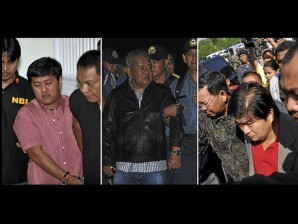SC: Live media coverage of Maguindanao massacre trial on

This combo shows file photos taken on Jan. 5, 2010 of National Bureau of Investigations (NBI) agents escorting the prime suspect in the country's worst political massacre Andal Ampatuan Junior (L) to a court hearing in Manila; on April 16, 2010 of former governor of the Philippine province of Maguindanao Andal Ampatuan Senior (C) at the Villamor Airbase in Manila; and on Dec. 5, 2010 of then ARRM governor Zaldy Ampatuan (R-in red shirt) being escorted by police officials to the CIDG office in General Santos City. AFP
MANILA, Philippines—(UPDATE 2) The Supreme Court allowed on Tuesday the live media coverage of the Maguindanao massacre trial.
The massacre claimed the lives of 57 civilians, including 15 women and 30 media practitioners in Ampatuan town, Maguindanao, on Nov. 23, 2009.
High Court Spokesman Jose Midas Marquez said the decision, penned by Associate Justice Conchita Carpio-Morales, took into consideration the impossibility of accommodating all parties inside the courtroom.
“It is about time to craft a win-win solution that shall not compromise rights…,” Justice Morales said. Majority of the 12 high court justices voted in favor of the live coverage. Those who did not vote were Chief Justice Renato Corona, who is on leave; Associate Justice Arturo Brion, who is on sick leave; and Associate Justice Antonio Eduardo Nachura, who has retired.
In a resolution penned by Associate Justice Conchita Carpio-Morales, the court took into consideration the impossibility of accommodating all parties inside the courtroom.
Article continues after this advertisement“It is about time to craft a win-win solution that shall not compromise rights in the criminal administration of justice, sacrifice press freedom and allied rights and interfere with the integrity and solemnity of judicial proceedings,” Morales said.
Article continues after this advertisementBelow are the guidelines for the coverage:
1. The audio-visual recording may be made both for documentary purposes and for transmittal to live radio and television broadcasting;
2. Media entities must file with the trial court a letter of application manifesting that they intend to broadcast the audio-visual recording of the proceedings and that they have the necessary technological equipment and technical plan to carry out the same with an undertaking that they will faithfully comply with the guidelines and regulation and cover the entire remaining proceedings until promulgation of judgment.
3. No selective or partial coverage shall be allowed.
4. No media entity shall be allowed to broadcast the proceedings without an application duly approved by the trial court.
5. There will be a single camera stationed inside the courtroom and all the other cameras will take its live feed from that camera so that SC-PIO will be putting a camera inside the courtroom and all other station whether TV or radio will be getting their live feed.
6. The broadcasting of the proceedings for a particular day must be continuous in its entirety excepting such portions where the Rules of Court excludes broadcast.
7. To provide a faithful and complete broadcast of the proceedings, no commercial break or any other gap shall be allowed until the day’s proceedings are adjourned except during period of recess called by the trial court and during portions of the proceedings where the public is ordered is excluded.
8. The proceedings shall be broadcast without any voiceovers except brief annotations of scenes, depicted therein as may be necessary to explain them at the start or at the end of the feeds.
9. No repeat airing of the proceedings shall be allowed except after the finality of judgment except brief footages and still images, cartographic sketches derived from the recording only for news purposes.
Marquez said there will be one camera to be stationed inside the courtroom where all the media entities would be getting their live feed.
Media entities wanting to air live the proceedings should apply before the Quezon City regional trial court Branch 221, which is conducting the trial.
“There should be no selective coverage. The media applying for live coverage permission should undertake to cover the entire proceedings up to its promulgation,” Marquez explained.
He added that there would be no commercial breaks until adjourned except during breaks or when the court excluded the public.
Media coverage of the trial for the Maguindanao massacre would be “pro hac vice,” or for this case only.
Earlier this year, the SC, through its spokesman, lawyer Jose Midas Marquez, said that the highest court of the land would not readily grant the petition for live media coverage of the trial.
In an interview, Marquez said there was still a need to balance the Constitutional rights of the accused as well as the rights of the public to information pertaining to the proceedings of the case against the Ampatuan family, who were pointed to as the alleged “mastermind” in the massacre.
The principal accused in the case were former Datu Unsay, Maguindanao Mayor Andal Ampatuan Jr.; former Maguindanao Gov. Andal Ampatuan Sr.; former acting Maguindanao Gov. Sajid Ampatuan; suspended Autonomous Region in Muslim Mindanao (ARMM) Gov. Zaldy Ampatuan; Akmad Ampatuan; Anwar Ampatuan and 196 others.
Marquez did note at the time that the SC was “open” to the call for “transparency” of court proceedings against the Ampatuans.
The National Union of Journalist of the Philippines (NUJP), and other media entities, had been consistent in their lobby to the high court, particularly to Chief Justice Renato Corona, that the trial be accorded live media coverage.
President Benigno Aquino III himself, as well as the influential Catholic Bishops Conference of the Philippines (CBCP), had likewise asked the SC to allow the live media coverage of the trial so that the public could follow the proceedings of the case.